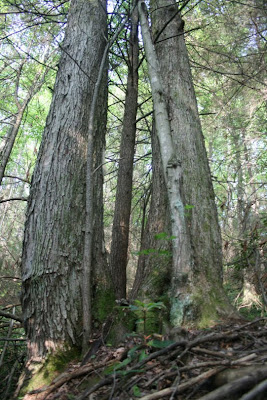 Decay doesn't have to take 100 years, sometimes just in your own life span humans can build things, and watch their tiny personal empire fall to pieces. There's always a hidden story, a mini drama, a loss, forgotten time or sometimes a death these places hold onto... but for the blue shack not very much longer.
Decay doesn't have to take 100 years, sometimes just in your own life span humans can build things, and watch their tiny personal empire fall to pieces. There's always a hidden story, a mini drama, a loss, forgotten time or sometimes a death these places hold onto... but for the blue shack not very much longer.Ya might notice there isn't any No Trespassing signs on this property, and that is because it is for sale - under $100,000 with 13 acres! ( If you want to know where it's located in Western North Carolina, send me an email.)
 The house is caving in. Literally. Porch posts leaning into a V shape, if you step on the covered porch floor boards your foot will go through it. Windows are broken, wood is bending, pieces of the roof are falling off.... yet it still holds it's bright blue spirit, you can still read some of the dreams that were afloat when it was built.
The house is caving in. Literally. Porch posts leaning into a V shape, if you step on the covered porch floor boards your foot will go through it. Windows are broken, wood is bending, pieces of the roof are falling off.... yet it still holds it's bright blue spirit, you can still read some of the dreams that were afloat when it was built. The back of the house pushes up to a rather steep hill, which is probably why the blue paint has washed off, the wall is pushing outward under the weight of the roof.... even a piece of the whole back wall has opened up and a freakin' lawn chair is poking out! Somehow that is creepy.
The back of the house pushes up to a rather steep hill, which is probably why the blue paint has washed off, the wall is pushing outward under the weight of the roof.... even a piece of the whole back wall has opened up and a freakin' lawn chair is poking out! Somehow that is creepy. Peeking into the windows, I didn't find much on the inside of the house --- the usual anticipation to see something beautiful in it's last run of decay was not really even there...
Peeking into the windows, I didn't find much on the inside of the house --- the usual anticipation to see something beautiful in it's last run of decay was not really even there... Unless you feel a toilet seat is beautiful....
Unless you feel a toilet seat is beautiful.... The ceiling is peeling off in sheets, which shows the rafters.... the rafters are the only thing about the structure that still looks stable. "Stable" being used real loosely.
The ceiling is peeling off in sheets, which shows the rafters.... the rafters are the only thing about the structure that still looks stable. "Stable" being used real loosely. Since there was 13 more acres of mystery to explore, I set off up the long winding road that led back up the side of the mountain. Plants & wildlife abound...
Since there was 13 more acres of mystery to explore, I set off up the long winding road that led back up the side of the mountain. Plants & wildlife abound... Raspberries!!! Mmmmmm - the berries will pop out those hairy shells....
Raspberries!!! Mmmmmm - the berries will pop out those hairy shells.... Blackberries ..... about to be ripe!
Blackberries ..... about to be ripe! Woodland Nettles and Jewelweed growing in patches together.... ( so if the nettles sting you, you can put the jewelweed on your skin to sooth it!)
Woodland Nettles and Jewelweed growing in patches together.... ( so if the nettles sting you, you can put the jewelweed on your skin to sooth it!) There was also a small hidden barn, with wide open slats --- it was totally covered in thorny wild roses making it impossible for me to go inside or get near it!
There was also a small hidden barn, with wide open slats --- it was totally covered in thorny wild roses making it impossible for me to go inside or get near it! Then a fresh deer track in the mud, it slid a little downward because of the steep part of the path...
Then a fresh deer track in the mud, it slid a little downward because of the steep part of the path... right next to the deer track was a patch of jewelweed (see the pic below) that the tops of the plants were eaten off....
right next to the deer track was a patch of jewelweed (see the pic below) that the tops of the plants were eaten off.... On my way back down I stopped to take a pic with the rocks being exposed from the erosion along the road... I LOVE big funky rocks! ANd I loooooove (not) trespassing. :)
On my way back down I stopped to take a pic with the rocks being exposed from the erosion along the road... I LOVE big funky rocks! ANd I loooooove (not) trespassing. :)




















 Anyone want to venture out and find what kind of moth this is (if ya get it I will blow you
Anyone want to venture out and find what kind of moth this is (if ya get it I will blow you 
























